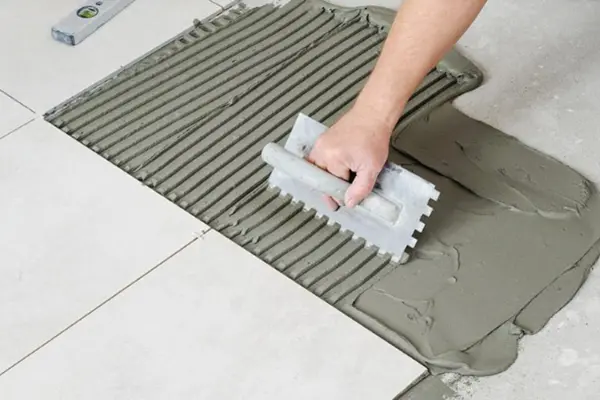Choosing the right trowel size is a crucial step when installing tile, as it directly affects the tile’s adhesion and the overall quality of the finished project. The size of the trowel determines how much adhesive, such as thin-set mortar, is spread onto the substrate, which in turn affects the bond between the tile and the surface below. But with various sizes and types of trowels available, how do you know which one is best for your tile installation? In this article, we’ll explore the different trowel sizes and their specific uses to help you make an informed decision.
Understanding Trowel Notches
Before diving into trowel sizes, it’s important to understand the terminology used. Trowels are characterized by the shape and size of their notches, which come in three main types: V-notch, U-notch, and square-notch. Each type serves different purposes:
- V-Notch Trowel: This trowel has V-shaped notches and is typically used for applying adhesive in thin, even layers. It’s ideal for smaller tiles and when minimal adhesive is needed.
- U-Notch Trowel: With U-shaped notches, this trowel spreads adhesive more generously than a V-notch trowel. It’s suitable for medium-sized tiles and provides better coverage and bond strength.
- Square-Notch Trowel: This trowel has square-shaped notches and is designed for larger tiles that require a thicker layer of adhesive. It ensures a strong bond by creating grooves that allow the tile to be pressed deeply into the adhesive.
Choosing the Right Trowel Size for Your Tile
The size of the trowel you use depends on several factors, including the size and type of tile, the type of substrate, and the adhesive you are using. Here’s a guide to help you choose the best trowel size for different types of tiles:
1. Small Tiles (Up to 4×4 inches)
For small tiles such as mosaic tiles or ceramic tiles up to 4×4 inches, a V-notch trowel with notches ranging from 3/16 inch to 1/4 inch is ideal. The V-notch trowel applies a thin layer of adhesive, which is perfect for these lightweight tiles that do not require a thick bed of mortar. This size ensures there’s enough adhesive to bond the tile without it oozing out excessively between the joints.
2. Medium-Sized Tiles (4×4 inches to 8×8 inches)
For medium-sized tiles, such as those measuring between 4×4 inches and 8×8 inches, a U-notch or square-notch trowel with 1/4 inch to 3/8 inch notches is recommended. This size provides adequate adhesive coverage and depth to support the weight of the tile and create a strong bond with the substrate. The grooves formed by the notches allow for better adhesive spread, which is important for preventing tiles from lifting or shifting.
3. Large Tiles (Over 8×8 inches)
Large tiles, including those over 8×8 inches, such as 12×12 inch tiles or larger, require a square-notch trowel with 1/2 inch or larger notches. This trowel size is necessary to create a thick enough layer of adhesive to support the weight and size of the tile. Large tiles need more adhesive to ensure full coverage and proper adhesion, as any voids under the tile can lead to cracking or shifting over time. A 1/2 inch square-notch trowel is typically used for 12×12 inch tiles, while a 3/4 inch square-notch trowel may be needed for tiles larger than 18×18 inches.
4. Natural Stone and Heavy Tiles
Natural stone tiles and other heavy tiles require even more adhesive coverage than large ceramic tiles. For these, a 3/4 inch square-notch trowel is often recommended, especially for uneven surfaces. The thicker layer of adhesive helps to ensure that all gaps are filled and that the tiles are firmly set. When working with heavy tiles, back buttering (applying a layer of adhesive to the back of the tile) may also be necessary to enhance the bond strength.
Factors to Consider When Choosing a Trowel Size
When selecting a trowel size for your tile project, consider the following factors:
- Tile Size and Type: As mentioned, the size and type of tile will largely determine the appropriate trowel size. Larger tiles and natural stone generally require larger notch sizes to ensure proper adhesive coverage and bond strength.
- Substrate Type: The surface onto which you are applying the tile also matters. For uneven surfaces or substrates that have imperfections, a larger notch size may be necessary to accommodate these variations and ensure the tile adheres properly.
- Adhesive Type: The type of adhesive or mortar being used can influence the choice of trowel. Thicker adhesives may require larger notches to spread evenly and provide sufficient bonding.
- Coverage Requirements: Always refer to the manufacturer’s recommendations for both the tile and adhesive. The manufacturer will often provide guidelines on the appropriate trowel size to use for their specific products.
Conclusion
Choosing the right trowel size is essential for a successful tile installation. It ensures that the adhesive is applied correctly, providing a strong bond and a durable finish. By understanding the different trowel types and sizes, and considering the tile size, substrate, and adhesive type, you can select the best trowel for your project. Whether you’re installing small mosaic tiles or large natural stones, using the correct trowel will make your work easier and result in a professional-looking finish.
Post time: Aug-27-2024







